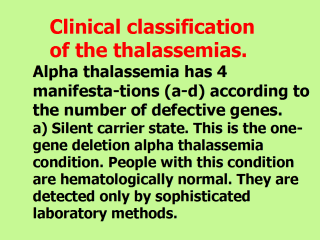| front |1 |2 |3 |4 |5 |6 |7 |8 |9 |10 |11 |12 |13 |14 |15 |16 |17 |18 |19 |20 |21 |review |
 |
b) Mild alpha-thalassemia.
These patients have lost 2 alpha globin genes. They have small red cells and
a mild anemia, confusable with simple iron deficiency anemia. c) Hemoglobin H disease. These patients have lost 3 alpha globin genes. The result is a severe anemia, with small, misshapen red cells and their fragments. These patients typically have enlarged spleens. Bony abnormalities particularly involving the cheeks and forehead are often striking. The bone marrow tries to compensate for the anemia. As a result, the marrow cavity within the bones is loaded with red cell precursors. These RBC populations gradually cause the bone to flair out. Patients with hemoglobin H disease also develop large spleens since the spleen has blood-forming cells. These cells become hyperactive and overexpand, just as those of the bone marrow. The result is a spleen that is often 10 times larger than normal. Patients with hemoglobin H disease often are small and appear malnourished, despite good food intake. This feature results from the tremendous amount of energy that goes into the production of new red cells at an extremely accelerated pace. The constant burning of energy by these patients mimics intense aerobic exercise; exercise that goes on for every minute of every day. d) Hydrops fetalis. This condition results from the loss of all 4 alpha globin genes. The affected individual usually succumbs to the severe anemia and complications before birth. |